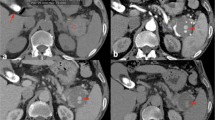Abstract
A 43-year-old man was admitted to a local hospital because of acute left abdominal pain. Chronic alcoholic pancreatitis and a 10-cm pancreatic pseudocyst in the tail of the pancreas had been found 5 years previously. He had not stopped drinking alcohol since then. On admission, laboratory tests revealed severe anemia, and contrast-enhanced computed tomography showed extravasation in the pancreatic pseudocyst. The spleen was retracted by the pancreatic pseudocyst, and its configuration was indistinct. The patient was diagnosed with acute bleeding within the pancreatic pseudocyst and splenic rupture. He was transferred to our university hospital on an emergency basis. Abdominal angiography of the splenic artery was immediately performed, but the bleeding point was not found. Although the bleeding stopped spontaneously, an infection of the pancreatic pseudocyst and a splenic hematoma subsequently developed. Endoscopic ultrasound-guided pseudocyst drainage was performed. The infection improved after the drainage, and the size of the pancreatic pseudocyst and splenic hematoma decreased. Five months later, the pancreatic pseudocyst had almost disappeared, and the splenic hematoma was even smaller. We herein report a rare case of splenic rupture caused by a pancreatic pseudocyst. Although the patient’s condition became complicated by severe infection, treatment by endoscopic ultrasound-guided drainage was successful.





Similar content being viewed by others
Abbreviations
- EUS:
-
Endoscopic ultrasound
- CT:
-
Computed tomography
- LAMS:
-
Lumen-apposing metal stent
References
Hernani BL, Silva PC, Nishio RT, et al. Acute pancreatitis complicated with splenic rupture: a case report. World J Gastrointest Surg. 2015;7:219–22.
Liu J, Feng Y, Li A, et al. Diagnosis and treatment of atraumatic splenic rupture: experience of 8 cases. Gastroenterol Res Pract. 2019. https://doi.org/10.1155/2019/5827694.
Moori P, Nevins EJ, Wright T, et al. A case of a chronic pancreatic pseudocyst causing atraumatic splenic rupture without evidence of acute pancreatitis. Case Rep Surg. 2016. https://doi.org/10.1155/2016/2192943.
Renzulli P, Hostettler A, Schoepfer AM, et al. Systematic review of atraumatic splenic rupture. Br J Surg. 2009;96:1114–21.
Irisawa A, Miyoshi H, Itoi T, et al. Recent innovations in therapeutic endoscopy for pancreatobiliary diseases. Dig Endosc. 2019;32:309–15.
Mooore EE, Cogbill TH, Jurkovich GJ, et al. Organ injury scaling: spleen and liver (1994 Revision). J Trauma. 1995;38:323–4.
Jain D, Lee B, Rajala M. Atraumatic splenic hemorrhage as a rare complication of pancreatitis: case report and literature review. Clin Endosc. 2019. https://doi.org/10.5946/ce.2019.087.
Girard E, Abba J, Cristiano N, et al. Management of splenic and pancreatic trauma. J Visc Surg. 2016;153:45–60.
Moya Sanchez E, Medina BA. Atraumatic splenic rupture as a complication of acute exacerbation of chronic pancreatitis, an unusual disease. Rev Esp Enferm Dig. 2017;109:477–8.
Zarrin A, Choksi V, Sorathia S, et al. Acute pancreatitis complicated by pancreatic pseudocyst and splenic hematoma. Am J Gastroenterol. 2019;114:S1638.
Kumtaa NA, Tyberg A, Bhagat VH, et al. EUS-guided drainage of pancreatic fluid collections using lumen apposing metal stents: an international, multicenter experience. Dig Liver Dis. 2019;51:1557–611.
Acknowledgement
We thank Angela Morben, DVM, ELS, from Edanz Group (https://en-author-services.edanzgroup.com/), for editing a draft of this manuscript.
Author information
Authors and Affiliations
Corresponding author
Ethics declarations
Conflict of interest
Naoyuki Hasegawa, Yoshimi Ito, Masamichi Yamaura, Masato Endo, Kazunori Ishige, Kuniaki Fukuda, Ichinosuke Hyodo, Yuji Mizokami declare that they have no conflict of interest.
Human and animal rights
All procedures followed have been performed in accordance with the ethical standards laid down in the 1964 Declaration of Helsinki and its later amendments.
Informed consent
Informed consent was obtained from all patients for being included in the study.
Additional information
Publisher's Note
Springer Nature remains neutral with regard to jurisdictional claims in published maps and institutional affiliations.
Rights and permissions
About this article
Cite this article
Hasegawa, N., Ito, Y., Yamaura, M. et al. Splenic rupture caused by pancreatic pseudocyst successfully treated by endoscopic ultrasound-guided drainage. Clin J Gastroenterol 13, 981–984 (2020). https://doi.org/10.1007/s12328-020-01152-1
Received:
Accepted:
Published:
Issue Date:
DOI: https://doi.org/10.1007/s12328-020-01152-1




